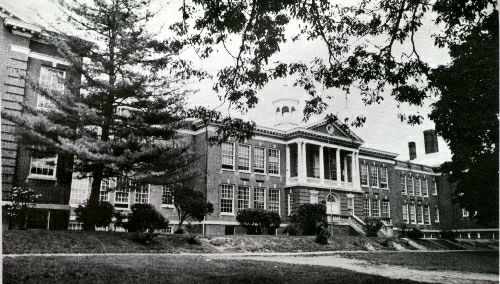
A Hanover Junior High
Research Project
Greg Cashman
Jane Hershey
Abbi-Lynn Jones
Peter Krum
Deborah Losee
Randall Stoner
Peggy Toot
Mitchell Weikert
Jane Winebrenner
Joann Wingert
Advisor: M. Sheridan Palmer
May 1978
We should like to
dedicate this research paper
to the memory of
CAPTAIN A. W. EICHELBERGER
May he never be forgotten.
|
|
Introduction
We began our research on the Eichelberger Building just looking for cold, hard facts. However, after a period of extensive research, we came to the conclusion that within our midst was more than just brick and mortar, but a building with a unique character and personality. In fact, it seems to have developed and matured almost like a human being.
The building was constructed in 1896 and functioned as a small, private academy. As such, its educational range was somewhat limited much like a child in infancy. When it became the property of the Hanover School District in 1900, its uses increased. In 1932, the structure reached the "prime of its life" with the addition of two wings and its conversion to a high school. Our current high school was finished in 1964, thus relegating the Eichelberger Building to the role of a junior high school. Now, like an elderly person, the structure is showing signs of age and deterioration and we wonder what lies ahead for it.
In the Eichelberger Building's eighty-plus years of existence, we estimate it has influenced and shaped the lives of 31,000 people; making it, in human terms, one of the most significant buildings in Hanover.
Our purposes in writing this paper were to learn the process of historical research; to tell the story of the Eichelberger Building; and to observe the changes in public education, as shown through this landmark, over three-quarters of a century.
Due to the limited resource materials and the fact that this paper is a joint project of ten junior high students, we have divided the paper into five segments. Pairs of students assumed the responsibility of researching the facts regarding the following stages in the evolution of the building: Abbi-Lynn Jones and Mitchell Weikert on the original structure; Peter Krum and Greg Cashman on the period 1900-1931; Peggy Toot and Deborah Losee on the Building as a high school; and Jane Hershey and Randall Stoner on the Building as a junior high. Joann Wingert and Jane Winebrenner researched the man for whom the Building is named.
We would like to express our thanks to Mr. Sheridan Palmer and Mrs. Phyllis Bush, teachers at the Hanover Junior High School, who gave much of their free time to our project. We would like to show special thanks to Mrs. Jane Miller who gave many of her mornings to Open the Hanover Public Library one hour earlier than usual, just so we could research our topic. We appreciated Mr. Bruce Rebert's visit in which he introduced us to the nature of historical research and provided helpful materials for our use. We are also grateful to Mr. Bert Elsner whose original research paper on Captain Eichelberger not only motivated us, but provided us with numerous leads in conducting our own research. Mrs. Betsy Winebrenner, Mrs. Helen Howells, and Dr. Elmer Stevens provided us with valuable source materials for which we are thankful.
Original Building
Around the time of the construction of the Eichelberg Academy in the late Nineteenth Century, life was quite simple. Basically, people worked, ate, slept, and in between there was a little entertainment in the form of gossiping among friends or going to the theatre.1 They earned little money but in turn needed little money. For example, Hanoverians could buy a suit for ten, twelve, or fifteen dollars; a hat for two dollars, and a cigar for five cents.2
April 9, 1896, the site for the Eichelberg Academy was established. The four acres on which the Academy was to be located were east of Carlisle Street on an elevated section of land north of the square.3 The Commons, public land for numerous purposes, was situated southeast of the Academy.4
"An oak tree standing near the Academy and in which the Capt. has taken pleasure, will be preserved as long as possible."5 Today, this massive oak tree dominates the campus and may be thought of as a living memorial to Captain Eichelberger. The Oak Leaf Award is, to this day, given to the outstanding boy and girl in the Senior Class. This award has originated from this tree
The Academy was of colonial style and constructed of brick with Indiana tone trimmings. The gracefully arched windows and the cupola surmounting the building gave it a measure of excellence.6
The furnishings were far more elegant in style than those of today, including things as: chandeliers, brass fixtures, a beautiful fountain, highly polished cypress trim, and double floors of yellow pine and maple.7 Captain Eichelberger and the following people erected the building which would house the academy: William A. Slagle, contractor; D. D. Bixler and Son, plumbing; C. Moul and Company, lumber; Charles Sprenkle, painting; and Mr. C. Davidson, heating.8
The intent of the preparatory school was to provide, at a minimal expense, a liberal education for the youth of the community before they attended college.9 As boys were expected to participate in military drills and discipline, a Hanover contemporary of Captain Eichelberger donated uniforms. It was felt such an institution would produce "a nation of erect, broadchested, healthy men."10
The Gift
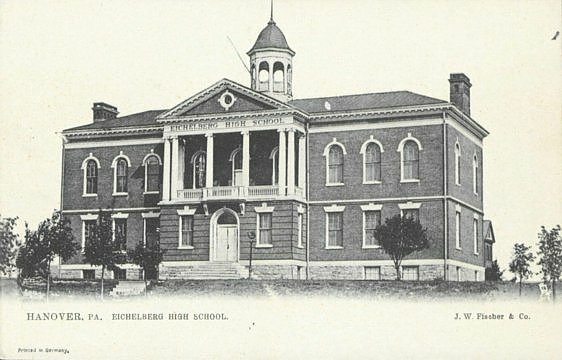 A
dramatic event took place during the 1900 Hanover High
School Commence exercises held at the Hanover Opera House.
Near the end of the exercises, Dr. C. M. Stock, pastor of
St. Mark's Lutheran Church, requested permission address the
audience. In his unscheduled speech, he noted that a
previous speaker had mentioned three things that Hanover
needed: a public library, a park, and a new high school
building. He went on to say that "the public library is on
the way (applause), and I believe the public park will come
(applause), he new high school building is here (long
continued applause)."11 The Reverend explained
that he was representing a most "lovable, broadminded,
greathearted, public-spirited man . . . Capt. A. W.
Eichelberger."12 Rev. Stock felt that the
eighty-one year-old gentleman had long been thinking of a
way to help Hanover. He concluded his speech:
A
dramatic event took place during the 1900 Hanover High
School Commence exercises held at the Hanover Opera House.
Near the end of the exercises, Dr. C. M. Stock, pastor of
St. Mark's Lutheran Church, requested permission address the
audience. In his unscheduled speech, he noted that a
previous speaker had mentioned three things that Hanover
needed: a public library, a park, and a new high school
building. He went on to say that "the public library is on
the way (applause), and I believe the public park will come
(applause), he new high school building is here (long
continued applause)."11 The Reverend explained
that he was representing a most "lovable, broadminded,
greathearted, public-spirited man . . . Capt. A. W.
Eichelberger."12 Rev. Stock felt that the
eighty-one year-old gentleman had long been thinking of a
way to help Hanover. He concluded his speech:
"Four years ago, he built Eichelberg Academy. Builders tell me that it is one of the best buildings in this community. After its erection, he conveyed it by deed to an association, to be used as an academy; but after a test it has been thought by the donor that the edifice would serve a better purpose as a public school building and as the representative of the President of the Association, I present to the Board of Directors the deed of this building and three acres of land, the only condition being that it be used for public school purposes forever. If it is worth one cent it is worth $30,000."13
Although the majority of the people present were surprised at this magnificent gift, the records show that Dr. Stock had attended the School Board meeting May 5, and informed them of Captain Eichelberger's intentions.14 To comply with the provisions of the deed, School Board President Dr. O. T. Everhart presented Dr. Stock with a one dollar note which was promptly given to a faculty member as a donation to the library fund.15
Rev. George B. Resser, who was sitting in the audience, stood and stated that although he was not asked to speak any more than Dr. Stock, he thought it would be improper if the thanks of the audience weren't returned to Captain Eichelberger. He then asked the audience to thank the Captain. The thunderous applause which greeted these remarks showed the deep gratitude of those present.16 It now seems appropriate to examine the life of the man who donated the gift.
Captain Eichelberger
Born in Hanover on December 6, 1819, Captain Abdiel Wirt Eichelberger was the fifth child of eight.17 He received the best education the town could give since his parents, Jacob Eichelberger and Maria Wirt, were quite wealthy.18 At eighteen, he was apprenticed to learn the carpenter's trade with Conrad Moul in Westminster for three years, but never followed that occupation.19
Although he was never in the United States Military Service,20 he was a popular military leader.21 He received the title "Captain" because of his leadership of two local military companies.22 The first of these, called the "United Blues," was organized in 1843. This infantry company of sixty men in full uniform continued to drill for seven years.23 During the Mexican War, the United Blues volunteered to enter the army but since the Pennsylvania Quota had been met, their services were not needed.24 The second company, "First Dragoons,'' was organized in 1849 by Captain Eichelberger. It consisted of fifty men in full uniforms furnished by the State. For five years they drilled once a month on the Public Commons of Hanover.25
One of Captain Eichelberger's earliest business ventures was an overland excursion to Georgia in 1843. Until 1852, he conducted a business shipping carriages and damask coverlets. He also owned a flour and a saw mill in Alabama at this time.26 The Captain spent winters in the South with his brother Jacob, and summers in Hanover working on his mother's land and drilling soldiers.27 He was also President of the Hanover Gas Company until 1886.28
Captain Eichelberger's main business interest was in railroad ownership and management. At the time of his death, he was the oldest railroad president in continuous service in the United States, having been President of the Hanover Branch, Baltimore & Hanover, Bachman Valley, Berlin Branch, and Baltimore & Harrisburg Railroad Companies.29
By 1888, Hanover was a town with a variety of businesses and a population of about 4000.30 Approximately 30 factories, many involved in the manufacturing of leather goods and in heavy industry, and about 110 stores, twenty-five other businesses, and a Chinese laundry served Hanover's citizens and provided employment.31 Post-Civil War Hanoverians could boast of their street cars, sewage plant, opera house with professional plays, and an indoor market as evidence of a thriving community.32 Though much smaller in population, Hanover was comparable to York in industrial strength and size.33
Besides these obvious assets, Hanover was fortunate to have Captain Eichelberger as a citizen. This influential person was known to be "benevolent, warm-hearted," and committed to the betterment of the community.34 When Hanover planned to ornament Centre Square, Mrs. Jacob Wirt, Jacob Forney, Colonel Cyrus Diller, and Captain Eichelberger each donated money for an iron fountain. This beautiful fountain remained in the center of the square until 1905, when it was removed to Wirt Park.35 It has since been sold and moved the Clearwater, Florida. After 1890 he purchased from the railroad a grove of trees which he intended to be a municipal park for Hanover. Although this never happened, it was called "Eichelberger Park" in his honor.36 As a measure of his importance and character, he had the privilege of riding with President Lincoln at the time of the Gettysburg Address.37
Besides having a philanthropic interest in the community, the Captain was concerned with education. In 1892, he contributed three thousand dollars to the Glenville Academy, situated eight miles south of Hanover. In 1894, he purchased an interest in the Academy and awarded a large number of free scholarships. It was then transferred to the General Synod of Hanover, with the pastor of St. Mark's Church as its representative.38 In 1896, with the erection of a new building in northwest Hanover, the Glenville Academy became the Eichelberg Academy. Four years later it was presented to the Hanover Public School System. This act endeared his name and reputation to the citizens of Hanover.39
Captain A. W. Eichelberger passed away on the thirteenth of June, 1901, at 8: 15 A.M. at his residence on Frederick Street. As a result of several accidents, he had been an invalid since February of 1893 and bedridden for the two weeks prior to his death.40 Relatives, business associates, and many citizens of Hanover showed their grief by attending his funeral on June 15. After short services were held at his residence, interment took place at Mount Olivet Cemetery, and services were then concluded at St. Mark's Church.41
The Town
By the turn of the Century, Hanover's population had grown to 5,300.42 By 1910, there were five constables, two policemen, and a Justice of the Peace maintaining law and order.43 As part of the business community, there were four banks, two loan associations, and forty-two incorporated companies.44
Averaging six random dates from 1900 to 1930 (1900,45 1913,46 1918,47 1924,48 1928,49 and 193050), we have tried to estimate the average public school enrollment of each year. In 1900, there were only ninety-two high school students on record. This figure more than doubled by 1913 to 194. In 1918, when the Eichelberg Building became a grammar school with grades one through eight, its enrollment increased to 288. During the 1920's, the student population grew until in 1930 it reached 312. Based on these figures, it is estimated that 7,140 students were educated in the Eichelberg (er) Building from 1900 to 1930.
Information of School activities during this period was hard to find. In the 1910-11 school year, the Eichelberg Building served as both a high school and a grade school, each division having four teachers.51 At some point the name of the structure was changed from Eichelberg Building, as it was in the old Academy days, to Eichelberger Building. Exactly when and how this change came about is unknown. The current colors of the Junior High, blue and gold, date back to 1929 when they were chosen at a meeting of the student newspaper staff.52
West Walnut Street Building
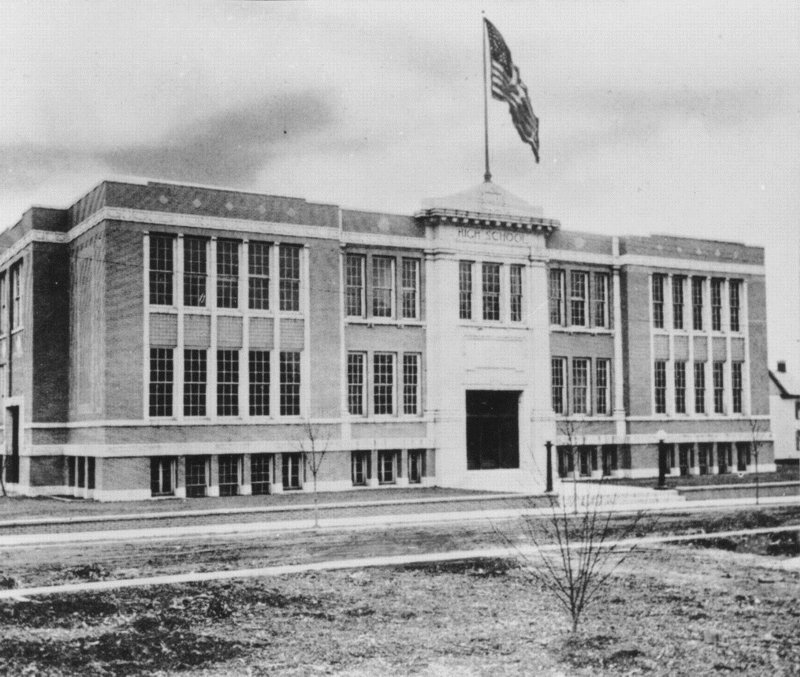 By
1930, the population of Hanover had grown to 15,140 with
ninety-nine percent being native born. The area of the
Borough was three and one-half square-miles. At this time,
Hanover had five financial institutions, 2,313 telephones,
seventeen churches, eighty-two factories (with an equal
number of male and female employees), three railroads, and
nine schools. The public was served by four paid and 746
volunteer firemen, along with a police department of five
men.53 It is clear that the first quarter of the
Twentieth Century had been a period of considerable growth
for the community. But this growth caused growing pains for
the public school system.
By
1930, the population of Hanover had grown to 15,140 with
ninety-nine percent being native born. The area of the
Borough was three and one-half square-miles. At this time,
Hanover had five financial institutions, 2,313 telephones,
seventeen churches, eighty-two factories (with an equal
number of male and female employees), three railroads, and
nine schools. The public was served by four paid and 746
volunteer firemen, along with a police department of five
men.53 It is clear that the first quarter of the
Twentieth Century had been a period of considerable growth
for the community. But this growth caused growing pains for
the public school system.
Hanover High School, now the West Walnut Building, was not placed on the accredited school list in 1931 because of crowded conditions and lack of facilities. It was felt that Hanover High graduates did not have equal opportunities with graduates of accredited schools.54
Although the West Walnut Street Building was designed to hold 250 students, by 1931, 522 pupils and twenty faculty members were crowded into the facility. Certain classrooms with a seating capacity of thirteen held an uncomfortable thirty-six students.55 The laboratories and equipment at the building were below the minimum standards established for "modern" high schools. The equipment in the science department was only enough to take care of about half the number of students enrolled in the science classes.56
The problem of an overcrowded gym was compounded by the lack of an efficient ventilation system.57 The students didn't want anything extra or fancy, just what they needed to be considered an accredited high school.58
Some citizens of Hanover hoped the loan, which would finance the necessary facilities, would pass the public vote; because if it didn't, school taxes would be substantially increased to pay for needed improvements. Passing the $225,000 loan would give the District its needed revenue.59
The proposed additions to the West Walnut Street Building included a section of at least six classrooms and a readjustment of the interior portion of the original building. These changes would have provided a library large enough to satisfy state requirements; a larger commercial department; science labs for physics, chemistry, and biology; a larger English department; more art and music space; and adequate physical and health education areas including healthful locker rooms separated from modern sanitary restrooms. With these alterations, all state requirements would be met and Hanover would have an accredited high school.60
The New High School
The proposed loan would also bring changes to the Eichelberger Building, then an elementary school. These changes, included adding wings to each end of the school and remodeling the inside, making it a combined elementary and junior high school. The plans provided for more classrooms; a science lab; commercial rooms; a library; an auditorium; gym facilities; industrial arts and home economics rooms; and rooms for music, art, and mechanical drawing. These would suffice to make the Hanover Junior High fully approved and accredited by the state.61
If the Eichelberger Building had not been substantially altered in 1932, it may not exist today; because most of the elementary school buildings built before 1900 have since been razed.
The school board had unanimously approved the $225,000 loan which was the only way of financing a needed building program.62 On May 5, 1931, the citizens of Hanover voted on the loan and it was approved by a ratio of two to one.63
There were significant differences between the architectural sketches published in May, 1931, and the building as it was constructed. For instance, the auditorium and gymnasium wings were in reversed positions. The original plans called for the Eichelberger Building to be a junior high and grade school, with an expanded Walnut Street Building serving grades ten through twelve.64 Searches of the Evening Sun, Orange and Black, and the 1931 School Board Minutes, did not reveal when or why variations were made in these original plans.
The ground for the new high school wings was broken at 2:00 P.M. on August 20, 1931. School Board President Philip Forney, after a short ceremonial speech, dug deep into the ground three times. After the ceremonies, contractor O. H. Hostetter and his team of eighty-five men began excavating.65
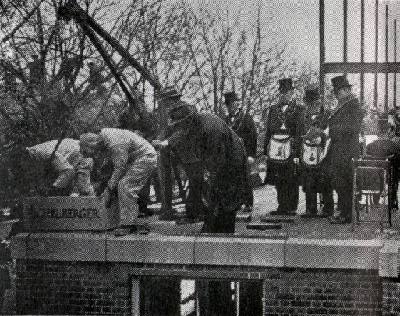 Four
months later, the cornerstone ceremonies were held. Mr.
Forney gave an address about the growth of public schools in
Hanover from 1836 to the present and his hopes for the
future. After this, the cornerstone was laid at the corner
of the McCosh Street wing. The contents, sealed in a copper
box, included: a Holy Bible, an American flag, a list of
teachers and pupils in the entire District, a list of Board
members, and the contractors and architects. Also, such
documents as a complete record of the school board minutes,
two copies of the Evening Sun, a copy of the Orange and
Black, the 1931 Nornir, and a copy of the program prepared
for these ceremonies plus several stamps and coins were
included.66
Four
months later, the cornerstone ceremonies were held. Mr.
Forney gave an address about the growth of public schools in
Hanover from 1836 to the present and his hopes for the
future. After this, the cornerstone was laid at the corner
of the McCosh Street wing. The contents, sealed in a copper
box, included: a Holy Bible, an American flag, a list of
teachers and pupils in the entire District, a list of Board
members, and the contractors and architects. Also, such
documents as a complete record of the school board minutes,
two copies of the Evening Sun, a copy of the Orange and
Black, the 1931 Nornir, and a copy of the program prepared
for these ceremonies plus several stamps and coins were
included.66
Four months later, the construction crew had about sixty-five per cent of the work done. The framework had been finished, the installation of new windows was almost completed and the brickwork was well underway.67
When the building was finished the following October, it was like looking at a new house. There was a great deal of bare ground, no shrubs, and two large wings of fresh brick and shiny glass. The center section of the structure had a principal's office, commercial rooms, two high school and three elementary classrooms, teachers' lounges, storage rooms, and a library. The library was very modern compared to most, having walnut bookcases, pewter lamps, seventy-five seats, and about five thousand books.68 The McCosh Street wing contained the gym and several class rooms, while the Eichelberger Street wing held the auditorium, contrary to the original plans. In the basement there were locker rooms, the cafeteria, and more classrooms.69
Even though the Eichelberger High School was not completed until October of 1932, the students began their fall term in the unfinished building. At this time, Fred Troxell was the principal and Frank Harston was superintendent. There were twenty-six faculty members and 425 students.70
During the first year, a student editorialized in the school newspaper:
At last we have a high school that the students and citizens of Hanover have been dreaming about for years. We have every new and accredited school need. We have twenty-six classrooms for our departments, but unless we take care of all these new facilities, they will not last long.
In our old building we had a small strip of grass that we called a campus. But now we truly have a real campus. What are we going to do with it? How are we going to use it?
At the present, most of us view the campus as just another field and a short cut to the entrances. We should have tennis courts and a hockey/soccer field. Why not combine beauty to utility?71
The tennis courts were built two years later.72
It was during its thirty-two years as a High School that the Eichelberger Building was utilized to its fullest extent. Students and fans were packed into the gymnasium for exciting interscholastic rivalries; band and orchestra concerts as well as dramas were performed in the auditorium with its graceful balcony. A basement room was converted to a wrestling room while the crawl space under the auditorium served as a rifle range for the rifle club.
The vents and wall spaces supposedly enabled an adventurous student to crawl from the stage area to the vent for the library on the second floor. From this vent, he was able to mischievously disrupt his more studious classmates with a variety of sounds.73 It should be noted that this bit of oral tradition remains unconfirmed although the maintenance superintendent has verified that such an escapade was possible.74
Through the 1930's and 40's the High School enrollment grew from 425 to 500 students. When the student body numbered 550 in 1960, the decision was made to construct a new high school facility.75 The Eichelberger Building stopped functioning as a high school for the same reason that it had been established as a high school in 1932--there was a need for bigger and better facilities.
When, in 1964, the new Hanover Senior High School was completed, the seventh and eighth grades were moved to the sixty-eight year-old structure and it became the Hanover Junior High School. During this transition, there were no changes made except a few minor interior alterations making the building more suitable for junior high needs.76 Other than a new boiler system installed in 1977, there have been few improvements to the building.77
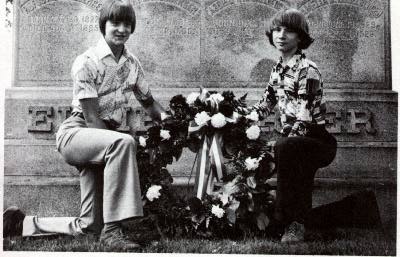 Hanover
Public School District secondary students have continued to
pay their respects to Captain Eichelberger in recent times.
His portrait hangs in the main corridor of the Junior High;
the 1932 and 1938 Nornirs were dedicated to him; and each
Memorial Day, two junior high students place a wreath on
Captain Eichelberger's grave.
Hanover
Public School District secondary students have continued to
pay their respects to Captain Eichelberger in recent times.
His portrait hangs in the main corridor of the Junior High;
the 1932 and 1938 Nornirs were dedicated to him; and each
Memorial Day, two junior high students place a wreath on
Captain Eichelberger's grave.
At the present, the stately Eichelberger Building is showing
signs of its advanced age and deterioration. In the
Indenture made the "sixteenth day of May, A. D., one
thousand nine hundred," on file at the York County
Courthouse and entitled, The Eichelberg Academy to the
Hanover School District, it is stated that
. . . All that piece or parcel of land, situate lying and being in the Borough of Hanover, York County, Pennsylvania, to be used and held for public school purposes forever and should any part or portion thereof cease from this use, the whole property shall revert to the legal heirs of Abdiel W. Eichelberger.
Having researched this subject, it is our sincere hope that "His Magnificent Gift" will continue to serve the youth of Hanover.
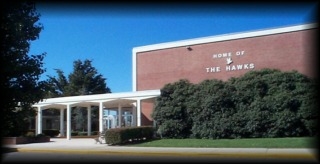
Current
High School located on Moul Ave.
Newspapers
Sources of Limited Publication
Unpublished Sources
Interviews